Later this week, AMD will launch its socket AM1/ FS1b based Kabini SoC’s, the fastest of which will be the Athlon 5350. The AMD Athlon 5350 will be the fastest 25w TDP socket AM1 processor at launch. It has four “Jaguar” cores running at 2.05GHz. The other side of the chip is its 128 core Graphics Core Next (GCN) cores running at 600MHz which AMD markets as a Radeon R3. We are not going to test the GPU today since we typically focus on CPU benchmarks with our Linux test suite. Still, we are very excited to see what these new Kabini APU’s can do.
Test Configuration
We were a bit limited by the fact that we purchased the components at retail prior to the official launch. AMD and ASUS did not provide these components prior to launch.
- CPU: AMD Athlon 5350 (with retail heatsink/ fan)
- Motherboard: ASUS AM1I-A
- Memory: 8GB (2x4GB) DDR3 1600MHz
- SSD: Samsung 840 Pro 256GB
- OS: Ubuntu 13.10 server
- Power supply: PicoPSU 150XT
4-8GB of RAM is likely going to be the sweet spot for these chips. Once you purchase 2x 8GB UDIMMs the small incremental price to move up to the next tier of processor and motherboard combinations is not too great.
AMD Athlon 5350 Benchmarks
The net goal is that we want others to be able to reproduce benchmarks and compare directly to their systems. Since we do not have access to every possible configuration, we would appreciate feedback in that thread which can be as simple as posting log files to run. Help is always appreciated!
Hardinfo Performance
hardinfo is a well known Linux benchmark that has been around for years. It tests a number of CPU performance aspects. One major advantage is that one can run this out of the box from many Ubuntu installations.
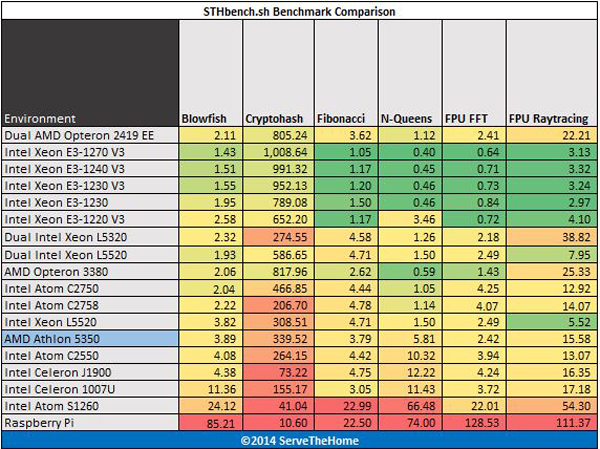
We do sort on UnixBench multi-threaded Dhrystone results. Generally hardinfo gives us a quick preview of the rest of the suite. For those wondering why we have dual processor results in here, consider this. A complete dual Xeon L5530 or AMD Opteron 2419 EE server can be purchased used, with RAM for about the same price as an AMD Athlon 5350 system. Likewise, Xeon L5520 pricing is under $25 per chip on ebay. We ended up spending more than $50 for the Athlon 5350 however that was pre-release retail pricing. Of course, all of these dual processor configurations are going to use more power but interesting nonetheless.
One thing we can see here is that the AMD Athlon 5350 is very competitive with the Intel Silvermont based offerings, and appears to be significantly faster than the lower-cost Intel Celeron 1007U platform we saw earlier. For a quick recap, the Celeron J1900 and Atom C2550 are quad core Silvermont architectures while the Atom C2750 and C2758 are 8-core variants. One can clearly see the AMD SoC is very competitive with Intel’s offerings released last fall in terms of CPU performance. The Xeon E3-1200 chips are all significantly faster, but are also more costly. They also serve as a solid proxy for desktop chips.
UnixBench 5.1.3 Performance
UnixBench may be a defacto standard for Linux benchmarking these days. There are two main versions, one that tests single CPU performance on that tests multiple CPU performance. UnixBench segments these results. We run both sets of CPU tests. Here are the single threaded results:

In terms of single-threaded performance, the AMD Athlon 5350 stacks up just behind the Intel Silvermont based Atom and Celerons. One can see that even the low power/ clocked and over 5 year old Nehalem L5520 chips are still significantly faster in most single threaded benchmarks.
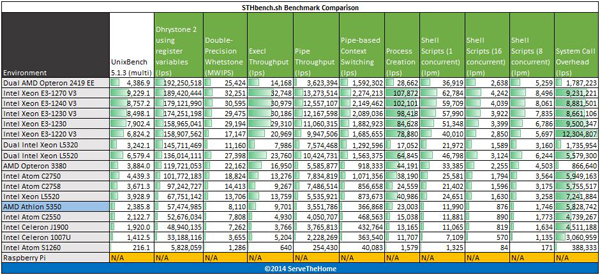
Moving to the multi-threaded side, we actually see that the AMD Athlon 5350 performs well against the quad core Silvermont parts. One other major takeaway from these charts is that low-power performance is slower than current generation desktop parts. However looking at a Haswell based Xeon E3-1270 V3 versus an AMD Athlon 350 there is less than a 4x differential in Dhrystone performance. On the other hand SoC’s like the Raspberry Pi and older Atom S1260 parts are generally about 1/10th the performance of the current crop of low-power processors.
c-ray 1.1 Performance
c-ray is a very interesting ray tracing benchmark. It provides both consistent results and some clear separation. Ray tracing is generally a great multi-threaded CPU benchmark. For this test we use both a simple 7500×3500 render and a more complex 1920×1200 render. Here are the results: Our c-ray benchmark shows some fairly solid performance using c-ray’s rendering benchmark.
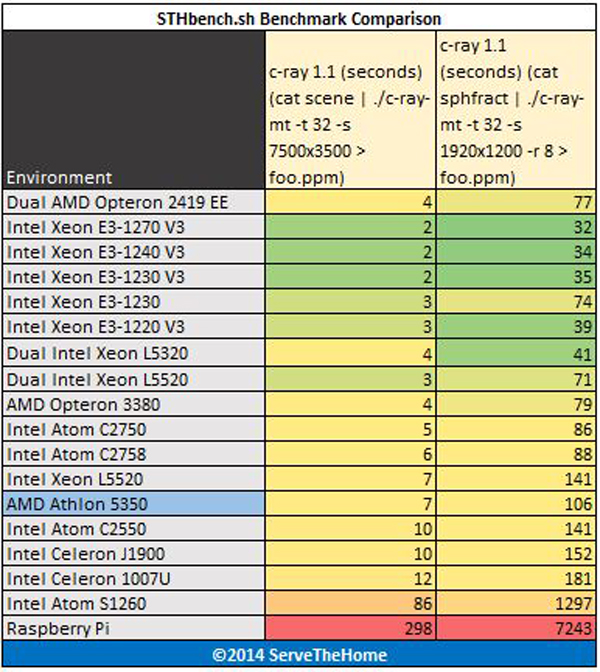
Here we see the AMD Athlon 5350 perform significantly better than the quad core Silvermont parts. The Athlon 5350 is even competitive with a single Intel Xeon L5520 here. The 8-core Silvermont processors are faster.
Phoronix Test Suite Performance
We are using four tests from the Phoronix Test Suite: pts/stream, pts/compress-7zip, pts/openssl and pts/pybench.
- STREAM by John D. McCalpin, Ph.D. is a very well known memory benchmark benchmark.
- 7-zip compression benchmarks were a mainstay in our Windows suite so we are including it again on the Linux side as a compression benchmark.
- The pts/openssl benchmark is very dependent on the CPU architecture being used
- Python is a widely used scripting language and pyBench is a nice single-threaded Python benchmark

Here we can see a significant flaw in the AMD Athlon 5350 design, memory bandwidth. The AMD Athlon 5350 is a single channel DDR3 design. Even with 1600MHz DDR3 memory, the bandwidth provided to the CPU is anemic. With two DIMM slots on the motherboard, one does wonder why AMD would not just go for a dual channel memory controller.
Crafty Chess Performance
Crafty is a well known chess benchmark. It is also one where we saw issues last time with the Phoronix Test Suite and running on ARM CPUs. We are planning to retire this benchmark in the 2014 version of STHbench. Here are the Crafty Chess results from simply running “crafty bench”:
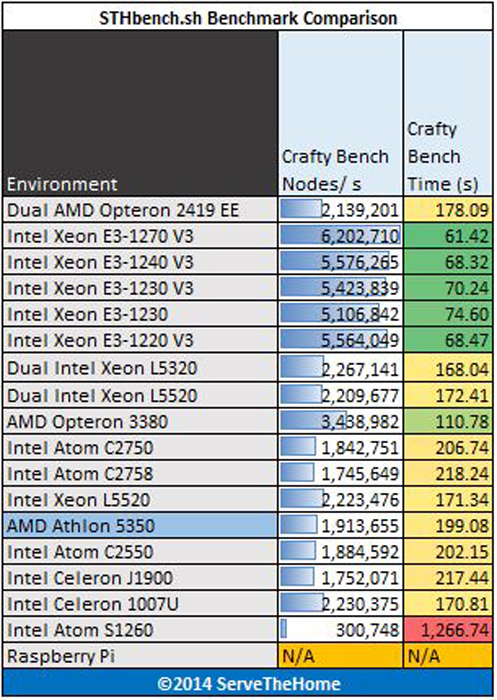
Here we again reinforce the trend that the AMD Athlon 5350 has single threaded performance close to that of Silvermont architecture processors.
Power Consumption and Thermal Imaging
We hooked up our Extech TrueRMS power meter to the AMD 5350 platform and saw some excellent results
- Idle power consumption: 15.9w
- Maximum power consumption during benchmarks: 20.0w
Just to give one an example of how good this is in the server realm, here are a few lower-power/ lower end server options:
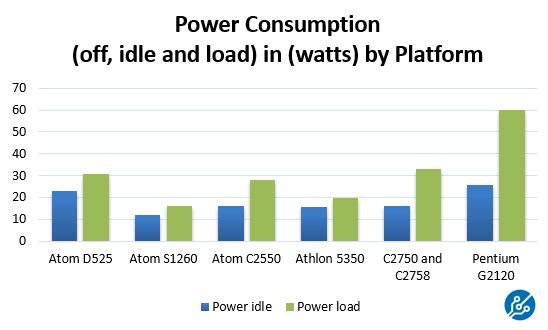
Overall, excellent results here but somewhat misleading. All of the other options were tested on platforms with a BMC which provides out-of-band IPMI 2.0 and iKVM management. For those not familiar with that functionality, most server motherboards have the ability to remotely login to a management engine and get a remote desktop/ terminal, and perform power control and monitoring functions. This does add 6-7w of power draw. Still, the Athlon results are excellent. Just to visually give an example of what this looks like using a nearly silent retail fan spinning at about 2000rpm to cool the processor, we used our FLIR Ex series thermal camera on the platform:

The bottom line here is that the entire platform runs very cool. We use 22C to 60C as our lower to upper bounds due to the fact that we test many dual processor setups. One can see the platform runs very cool.
Conclusion
Overall, the AMD AM1 platform is fairly compelling. With a FS1b socket, there are a variety of options for different processors and a potential upgrade path. From our Linux benchmarking, we can see that the platform is highly competitive with the Intel Silvermont based Atom C2000 series and Bay Trail-D in terms of raw processor performance. Kabini delivers in that respect. Frankly, memory bandwidth is bad. I am interested to see how the AMD R3 graphics perform with very little main memory bandwidth. Given what we saw today, the $5-10 upgrade price versus the AMD Athlon 5150 is going to be an obvious one. The bigger question is whether it is worth it to upgrade to a quad core model versus dual core models. We do have two Sempron dual core models en-route to test so that answer should be coming shortly.

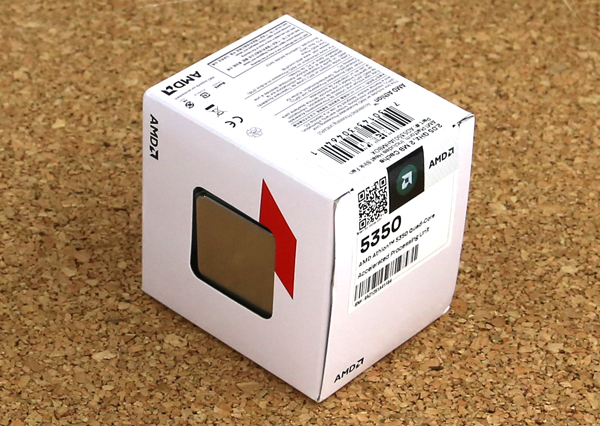



Can you do a pfsense build article with this setup? Maybe try ecc ram and Intel NICs on it?